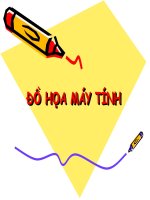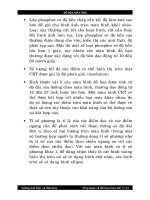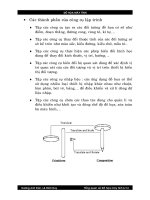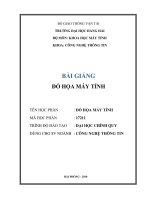Texture mapping (đồ họa máy TÍNH SLIDE)
Bạn đang xem bản rút gọn của tài liệu. Xem và tải ngay bản đầy đủ của tài liệu tại đây (8.04 MB, 51 trang )
Texture Mapping
Texture Mapping
• Important topic: nearly all objects textured
– Wood grain, faces, bricks and so on
– Adds visual detail to scenes
• Meant as a fun and practically useful lecture
Polygonal model
With surface texture
2
Adding Visual Detail
• Basic idea: use images instead of more
polygons to represent fine scale color variation
3
Parameterization
+
geometry
=
image
texture map
Q: How do we decide where on the geometry each
color from the image should go?
4
Option: Varieties of projections
5
[Paul Bourke]
Option: unfold the surface
[Piponi2000]
6
Option: make an atlas
charts
atlas
surface
[Sander2001]
7
Option: it’s the artist’s problem
8
OPENGL TEXTURE MAPPING
9
OpenGL Texture Mapping
• Apply a 1D, 2D, or 3D image to geometric
primitives
• Uses of Texturing
–
–
–
–
Simulating materials
Reducing geometric complexity
Image warping
Reflections
10
How to map object to texture?
y
z
x
geometry
t
screen
image
s
To each vertex (x, y, z in object coordinates),
must associate 2D texture coordinates (s, t)
So texture fits “nicely” over object
11
Idea: Use Map Shape
• Map shapes correspond to various projections
– Planar, Cylindrical, Spherical
• First, map (square) texture to basic map shape
• Then, map basic map shape to object
– Or vice versa: Object to map shape, map shape to
square
• Usually, this is straightforward
– Maps from square to cylinder, plane, sphere well
defined
– Maps from object to these are simply spherical,
cylindrical, cartesian coordinate systems
12
Planar mapping
• Like projections, drop z coord (s, t) = (x, y)
• Problems: what happens near z = 0?
13
Cylindrical Mapping
• Cylinder: r, θ, z with (s, t) = (θ/(2π), z)
– Note seams when wrapping around (θ = 0 or 2π)
14
Spherical Mapping
• Convert to spherical coordinates: use latitude/long.
– Singularities at north and south poles
15
Cube Mapping
16
Cube Mapping
17
Texture Mapping and the OpenGL Pipeline
• Images and geometry flow through separate
pipelines that join at the rasterizer
– "complex" textures do not affect geometric complexity
vertices
geometry pipeline
rasterizer
image
pixel pipeline
18
Texture Example
• The texture (below) is
a 256 x 256 image
that has been
mapped to a
rectangular polygon
which is viewed in
perspective
19
Applying Textures I
Three steps
• Specify texture
– Read or generate image
– Assign to texture
• Assign texture coordinates to vertices
• Specify texture parameters
– Wrapping, filtering
20
Applying Textures II
•
•
•
•
•
•
•
•
Specify textures in texture objects
Set texture filter
Set texture function
Set texture wrap mode
Set optional perspective correction hint
Bind texture object
Enable texturing
Supply texture coordinates for vertex
– Coordinates can also be generated
21
Texture Objects
• Like display lists for texture images
– One image per texture object
– May be shared by several graphics contexts
• Generate texture names
glGenTextures(n, texIds[]);
– Returns n currently unused names for texture objects
in the array texIds.
• Delete texture objects
glDeleteTextures(n, texIds[])
22
Texture Objects (cont.)
• Create texture objects with texture data and state
glBindTexture(target, texId)
– for the first time, a new texture object is created and
assigned that name.
– When binding to a previously created texture object,
that texture object becomes active.
– When binding to a texId value of zero, OpenGL stops
using texture objects and returns to the default texture.
• Bind textures before using
glBindTexture(target, id);
23
Specify Texture Image
• Define a texture image from an array of texels in
CPU memory
glTexImage2D( target, level, components,
w, h, border, format, type,
texels[] );
– dimensions of image must be powers of 2
• Texel colors are processed by pixel pipeline
– pixel scales, biases and lookups can be done
24
Converting A Texture Image
• If dimensions of image are not power of 2
gluScaleImage(format, w_in, h_in,
type_in, data_in[], w_out, h_out,
type_out, data_out[]);
– *_in is for source image
– *_out is for destination image
• Image interpolated and filtered during scaling
25









